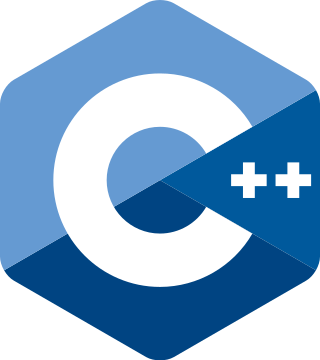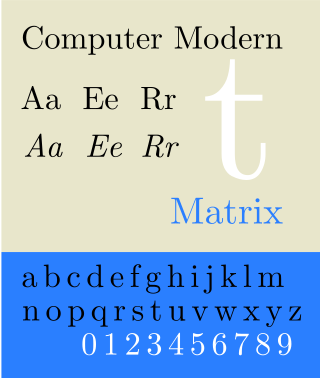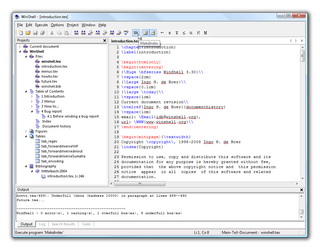Related Research Articles

Donald Ervin Knuth is an American computer scientist and mathematician. He is a professor emeritus at Stanford University. He is the 1974 recipient of the ACM Turing Award, informally considered the Nobel Prize of computer science. Knuth has been called the "father of the analysis of algorithms".

LaTeX is a software system for typesetting documents. LaTeX markup describes the content and layout of the document, as opposed to the formatted text found in WYSIWYG word processors like Google Docs, LibreOffice Writer and Microsoft Word. The writer uses markup tagging conventions to define the general structure of a document, to stylise text throughout a document, and to add citations and cross-references. A TeX distribution such as TeX Live or MiKTeX is used to produce an output file suitable for printing or digital distribution.

Martin Fowler is a British software developer, author and international public speaker on software development, specialising in object-oriented analysis and design, UML, patterns, and agile software development methodologies, including extreme programming.

The Art of Computer Programming (TAOCP) is a comprehensive monograph written by the computer scientist Donald Knuth presenting programming algorithms and their analysis. Volumes 1–5 are intended to represent the central core of computer programming for sequential machines.

James Arthur Gosling is a Canadian computer scientist, best known as the founder and lead designer behind the Java programming language.

C++ is a high-level, general-purpose programming language created by Danish computer scientist Bjarne Stroustrup. First released in 1985 as an extension of the C programming language, it has since expanded significantly over time; as of 1997, C++ has object-oriented, generic, and functional features, in addition to facilities for low-level memory manipulation for systems like microcomputers or to make operating systems like Linux or Windows. It is usually implemented as a compiled language, and many vendors provide C++ compilers, including the Free Software Foundation, LLVM, Microsoft, Intel, Embarcadero, Oracle, and IBM.
The Standard Template Library (STL) is a software library originally designed by Alexander Stepanov for the C++ programming language that influenced many parts of the C++ Standard Library. It provides four components called algorithms, containers, functions, and iterators.
In software engineering, a Design Pattern describes a relatively small, well-defined aspect of a computer program in terms of how to write the code.

Leslie B. Lamport is an American computer scientist and mathematician. Lamport is best known for his seminal work in distributed systems, and as the initial developer of the document preparation system LaTeX and the author of its first manual.

The device independent file format (DVI) is the output file format of the TeX typesetting program, designed by David R. Fuchs in 1979. Unlike the TeX markup files used to generate them, DVI files are not intended to be human-readable; they consist of binary data describing the visual layout of a document in a manner not reliant on any specific image format, display hardware or printer. DVI files are typically used as input to a second program which translates DVI files to graphical data. For example, most TeX software packages include a program for previewing DVI files on a user's computer display; this program is a driver. Drivers are also used to convert from DVI to popular page description languages and for printing.

Computer Modern is the original family of typefaces used by the typesetting program TeX. It was created by Donald Knuth with his Metafont program, and was most recently updated in 1992. Computer Modern, or variants of it, remains very widely used in scientific publishing, especially in disciplines that make frequent use of mathematical notation.

WinShell is a freeware, closed-source multilingual integrated development environment (IDE) for LaTeX and TeX for Windows.
MakeIndex is a computer program which provides a sorted index from unsorted raw data. MakeIndex can process raw data output by various programs, however, it is generally used with LaTeX and troff.
In typesetting, a strut is an invisible character or element, used to ensure that a text has a minimum height and depth, even if no other elements are included.
In computing, Pic is a domain-specific programming language by Brian Kernighan for specifying line diagrams. The language contains predefined basic linear objects: line, move, arrow, and spline, the planar objects box, circle, ellipse, arc, and definable composite elements. Objects are placed with respect to other objects or absolute coordinates. A liberal interpretation of the input invokes default parameters when objects are incompletely specified. An interpreter translates this description into concrete drawing commands in a variety of possible output formats. Pic is a procedural programming language, with variable assignment, macros, conditionals, and looping. The language is an example of a little language originally intended for the comfort of non-programmers in the Unix environment.

In typography, a thin space is a space character whose width is usually 1⁄5 or 1⁄6 of an em. It is used to add a narrow space, such as between nested quotation marks or to separate glyphs that interfere with one another. It is not as narrow as the hair space. It is also used in the International System of Units and in many countries as a thousands separator when writing numbers in groups of three digits, in order to facilitate reading. It also avoids the ambiguity of the comma, used as a thousands separator in many countries but as a decimal point in Europe.

Lincoln David Stein is a scientist and Professor in bioinformatics and computational biology at the Ontario Institute for Cancer Research.

Sebastian Patrick Quintus Rahtz (SPQR) was a British digital humanities information professional.
LY1 is an 8-bit TeX encoding developed by Berthold Horn.
References
- Wiedmann, Michael (2004-10-29). "Chapter 7. xindy". References for TeX and Friends, Revision 0.3.8. TUG . Retrieved 2007-12-03.
- ↑ Mittelbach, Frank; et al. (April 22, 2004). "Chapter 11: Index Generation". The LATEX Companion: Second Edition. Addison Wesley Professional. ISBN 0-201-36299-6 . Retrieved 2007-12-03.
- ↑ Mittelbach, Frank; et al. (April 22, 2004). "Chapter 11.3. xindy—An alternative to MakeIndex". The LATEX Companion: Second Edition. Addison Wesley Professional. ISBN 0-201-36299-6 . Retrieved 2007-12-03.
- ↑ "Xindy - A Flexible Indexing System".